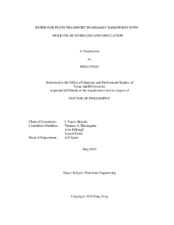| dc.description.abstract | Transport of small hydrocarbon molecules inside organic nanopores is important to our understanding of oil and gas production from source rocks such as shale. Unlike flow in conventional reservoirs, the fluid transport in unconventional reservoirs involves kerogen pore structure with much smaller capillaries. This, in turn, leads to large capillary wall surface area and, consequently, to a significant physical adsorption effect. Measurements are needed to understand the nature of flow inside kerogen structures. However, direct measurements are difficult and have large uncertainties related to kerogen isolation. Non-equilibrium molecular dynamics simulation allows numerical study of fluid transport inside model nanocapillaries representative of kerogen matrices.
First, we studied the transport in 1-D in single nanocapillaries. Based on the simulation results we observe that fluid flow velocity and mass flux are significant near the capillary surfaces where adsorption takes place. Hence, Hagen-Poiseuille equation based on the no-flow condition at the wall significantly underestimates the fluid flow in nanocapillary. The dependence of surface transport velocity, as well as flow enhancement, are determined quantitatively.
Second, we expand our study into 3-D nanoporous networks. Existing molecular models use nanoscale capillaries and do not describe the exact geometric structure of the organic nanopores in real source rocks, especially for mesopores, which widely exist in organic solids and are crucial for fluid transport in the source rocks. Here we present a new method to simplify the existing molecular kerogen models. Pore structures can be built to reflect the exact porous structure of hydrocarbon bearing kerogen pores for fluid transport without losing accuracy. The kerogen pore network skeleton can be populated based on 3-D digital segments obtained from high-resolution TEM tomographs. We introduce a simplified molecular model approach to work with significantly larger volumes of 3-D segments. To test the transport simulation accuracy using molecular dynamics for this simplified model, sample pore network structures are populated with both the existing exact molecular model and the simplified model, the permeability of reservoir fluid flowing through the media is simulated and compared. The simplified kerogen model can be easily applied to larger organic porous material samples to reduce spatial uncertainty. | en |


